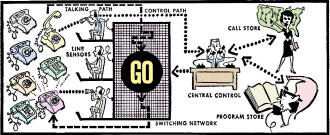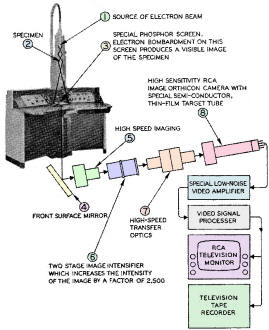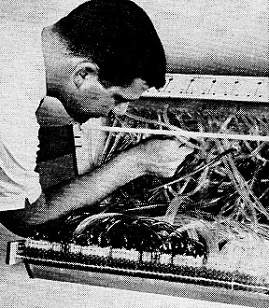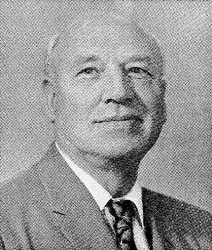|
December 1964 Radio-Electronics
 [Table of Contents] [Table of Contents]
Wax nostalgic about and learn from the history of early electronics.
See articles from Radio-Electronics,
published 1930-1988. All copyrights hereby acknowledged.
|
"Semipermanent"
magnetic memory is reported here in this 1964 Radio-Electronics
magazine news item. The term semipermanent is an awfully good, clearly
confusing, but seriously funny example of an oxymoron, akin to jumbo shrimp, old
news, random order, and unbiased opinion. An electronic switching system is
announced which will replace the massive network of electromechanical switches
in the nation's telephone system. Once implemented, the cacophony of clicking relays heard inside
the switch rooms containing thousands of of the noisy little buggers would go
silent. I remember being in such a facility in the mid-to-late 1970s where the
electromechanical relays were still being used, so it was well over a decade
before a total switchover (see what I did there?) was completed. Also covered
was a computer built by Univac that used fluid amplifiers (literally a fluid,
including air). Also, there was news of the "World's Greatest Amateur," John L. Reinartz, W1XAM, having attained Silent Key status. I
provided the color.
New Briefs:
11/57 |
8/58 |
11/59 |
2/60 |
4/60 |
8/60 |
9/60 |
10/60 |
12/60 |
1/61 |
3/61 |
5/61 |
6/61 |
7/61 |
8/61 |
11/61 |
12/61 |
1/62 |
2/62 |
3/62 |
4/62 |
7/62 |
8/62 |
9/62 |
3/63 |
4/63 |
8/63 |
9/63 |
3/64 |
8/64 |
12/64 |
1/67 |
3/67 |
4/67 |
5/67 |
6/67 |
9/67 |
4/68 |
9/68
News Briefs
 Electronic Switching System for Future Telephones Electronic Switching System for Future Telephones
An electronic telephone-switching system will soon begin to replace present electromechanical
systems in Bell Telephone offices, according to a report by Bell Telephone Labs
and Western Electric engineers to a gathering of the press at Holmdel, N.J. The
new system will offer a variety of telephone services not usually possible with
the present systems. Among the advantages will be:
Abbreviated dialing, by which frequently called numbers can be reached by dialing
an abbreviated two-to four-digit call instead of the regular long one.
Call transfer, which means that a person can dial a code and then the number
of a nearby telephone. This will cause all his incoming calls to be transferred
to that telephone.
Also available will be a signal which will tell a person telephoning that another
call is trying to get through.
These, and other services now not even thought of, may be possible because the
new technique uses a program control system of magnetic memories. Instructions for
providing services and processing telephone calls can be modified or removed and
new ones added by simply removing memory cards and "rewriting" the information on
them. In today's system it would probably be necessary to rewire systems to provide
additional services.
The electronic switching system will begin operation shortly in Succasunna, N.J.,
followed by electronic central offices on a limited basis in New York City, Washington,
D.C., and Norfolk, Va. All new offices will use the electronic switching system,
and equipment will be replaced gradually in existing offices.
The new system reduced to pictures. Line sensors scan all phones served by the
office every tenth of a second, detect a call far service when phone is lifted off
hook, alert the executive section (central electronic control), which goes into
the program stare to set up the call, passes the command to the switching network,
and the talking path is completed (to the lower telephone). Central control is a
computer which uses approximately 30,000 transistors and 45,000 diodes. It works
with two memories, program store and the call store. The program store is a semipermanent
magnetic memory that contains all long-term instructions (such as haw to set up
call transfers, etc.) The call store is a short-term memory which would be used,
for example, for data having to do with a particular call.

How the intensification system works. The numbered callouts
are self-explanatory, with the exception of 5 and 7, which refer simply to
large-aperture optical lenses.

UNIVAC engineer R. S. Gluskin attaches a plastic tube to one
of the elements in the experimental digital computer that works with fluid
amplifiers and air.
Electron
Microscope Power Boosted by TV Technique
A technique that will make it practical to increase the magnification of an
electron microscope from 200,- 000 times to 2,000,000 times was described by RCA
at a press conference in Princeton, N.J. (At this magnification, a man's foot
would be 400 miles long.)
By using image intensification and television projection, it is possible to
use a much weaker beam in the electron microscope itself. Heretofore the
microscope could not be used to its full capability, because in many cases the
specimen being examined would be destroyed by the beam. Now, by intensifying
(amplifying) the visible image, it is possible to start with a much weaker image
.
Another important advantage is that the contrast of an image can be increased
beyond what would be possible with the straight electron microscope. A contrast
control, not greatly different from that in an ordinary television set, can
bring up the contrast. Contrast can sometimes also be improved by reversing the
image making it a negative instead of a positive -something that couldn't be
done with the old electron microscope.
To produce these effects, the original electron microscope is focused on a
phosphor screen at the original viewing point. From here it moves through a
high-speed lens with a two-stage image intensifier. An image intensifier
incorporates a photocathode, on which the image is focused, and which then
produces electrons in the pattern of the visible image. These are accelerated to
a screen where they produce an image of the same size but brighter. In the
two-stage intensifier, this screen is a second photocathode, and the image is
intensified again.
It is then focused on the camera tube of an image orthicon camera, amplified
through special video amplifiers and projected on the TV screen.
The equipment also includes a video tape recorder, so that permanent records
can be made. The apparatus is in production form, ready to be delivered, either
as complete equipment or as an addition to existing electron microscopes.
Experimental Computer Has Fluid Amplifiers
Air flowing to 250 molded plastic switching elements through a complex
network of channels enables a new, experimental computer to perform basic
computer functions. Developed by Sperry Rand Corps, Univac Div., the new
computer is far from being a practical model, having a capability of only four
instructions and four words of memory. Each word is four bits long.
The fluid amplifier on which this computing system is based is a device that
somewhat resembles an electronic triode. A jet of fluid - which may be air - is
propelled from a nozzle or cathode toward a collector, which may be placed to
intercept half the stream. A small jet of fluid is directed at the base of the
main stream, at right angles to it. The relatively strong main stream is
deflected by the small jet, which uses little energy, so the device amplifies.
(See Radio-Electronics, August 1960, p. 56).
The fluid amplifier has already been used practically. The Army has developed
a mechanical heart based fluid-amplifier principles. The same principle has been
used for large hydraulic valves that work without moving parts. The Sperry Rand
device, however, is the first attempt to use it as a computer, where it may
eventually be practical in applications where high speed is not needed.
Fluid-operated circuits can be constructed for a small fraction of the cost of
conventional electronic computer circuitry. They are likely to be more reliable
and can withstand higher and lower extreme temperatures, as well as nuclear
radiation.
 John L. Reinartz, W1XAM John L. Reinartz, W1XAM
John L. Reinartz, "World's Greatest Amateur," died Oct. 6 in California at the
age of 70.
He was known to a generation of amateurs and experimenters as the inventor of
the tuning circuit that was the basis for the majority of short-wave receivers in
the '20's, as a pioneer in short-wave communications and as a researcher who played
an important part in exploring the regions of increasingly higher frequencies.
Reinartz, though of French descent, was born in Krefeld, Germany, and came to
the United States at the age of 10. His parents settled in South Manchester, Conn.
He became interested in radio while he was still in school, and continued his hobby
while working as a clerk in a dry goods store and later in the electrical department
of a silk mill.
In 1923 he took part in the first two-way radio contact across the Atlantic,
with Leon Deloy of the French amateur station 8AB, on approximately 100 meters.
When the MacMillan National Geographic Arctic Expedition was started in 1925, he
was selected by Capt. Donald B. MacMillan as operator because of his capabilities
and experience in short-wave radio.
Later he joined the technical staff of the amateur magazine QST, and also contributed
many articles to other publications. Reinartz had many opportunities to become wealthy
on his inventions, but remained a strict amateur, dedicating his discoveries to
the public and refusing to allow major radio companies to use his name in advertisements.
During World War II he was in charge of radio training for the Naval Communications
Reserve, with the temporary rank of captain. In 1949 he joined Eitel-McCullough,
a tube manufacturer well known to hams. He headed the company's amateur service
department until his retirement in 1960.
Mr. Rienartz held an earlier call, 1QP, before making W1XAM famous throughout
.the world. After moving to the West Coast, he held the call K6BJ. He was a member
of the Explorers Club of New York, Fellow of the IEEE, member of the American Polar
Society and an associate member of the Naval Institute.
Brief Briefs:
Citizens-Band
Citizens-Band interference to television is becoming serious in metropolitan
areas. The New York office of the FCC reports that the number of complaints of CB
interference to TV has risen to 900 a month. Owners complain of jiggling lines in
the picture, and "adolescent voices" on the sound channel.
Color television plans in Great Britain
Color television plans in Great Britain will probably not come to fruition until
1967, and the BBC expects to use its noncommercial second channel for color programming.
Set manufacturers will probably use RCA tubes.
Posted February 22, 2024
|












 John L. Reinartz, W1XAM
John L. Reinartz, W1XAM 